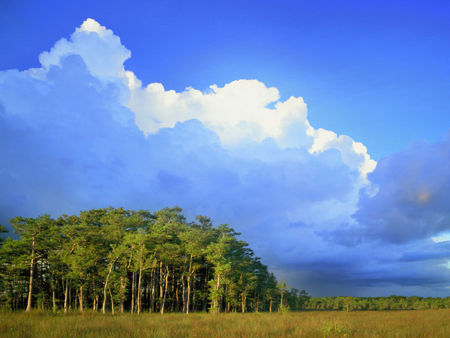The "one in Florida" is the Belted Kingfisher, or "Megaceryle alcyon." (Can you even pronounce the words?)
More stuff here: http://en.wikipedia.org/wiki/Belted_Kingfisher
Watch the birds. You never know what you might see!
Beautiful Bird Spotted on New Year's Eve!
The final post for this year and this decade couldn't be better than this photo of a Great Blue Heron, looking for his breakfast this morning. I've seen (and shot photos of) a lot of herons, but this fellow is definitely the most handsome bird I've ever seen. I'm so very glad I had my camera handy! Although, seeing him with my own two eyes is the ultimate gift. What a beauty, huh? Now you know why I love living here in south Florida, in the Everglades!
HAPPY NEW YEAR TO ALL!

Upon arriving at the office this morning around 8 AM,
this pair was basking in the glow of the morning sun.
Often called buzzards or carrion crows, turkey vultures are not related to either family. One of two vultures found throughout south Florida, the turkey vulture is protected by Federal law and cannot be killed without proper permits from the U.S. Fish and Wildlife Service.
The turkey vulture is approximately twenty-five inches tall and weighs from 3.5 to 5.3 pounds. The wingspan measures some seventy-two inches. This bird is blackish brown and has its own distinguishing features. As you can see in the photograph, they have a red head and legs, the tips of the bills are white, and the undersides of their wings are lined in gray. In flight, their tails extend past their legs.
It's iguana mating season in south Florida and these guys are everywhere! Here along our canal this morning I counted 16 iguanas of all sizes. In this photo, you can see two, but there were four more scattered around the Brazilian Pepper tree. Keep in mind that both the critters and the tree are invasive exotic species ... but they sure are fascinating to watch!
I've decided to capture images of birds I see every day. Now, I see birds every day. But, I don't always have my camera in my hand. Which is about to change for this little "bird a day" project of mine. Let's see what happens ...
These little guys are a fairly common site around these parts. Of course, with a cow pasture next door to my office, I may get to see them more often than others, but you still see them quite often even in the dense urban areas along the east side of the county.
Found this info on the Seminole Audubon web site:
Bubulcus ibis (BUE-bul-kus EYE-bis) Other Names: Cattle heron, cattle egret, buff-backed heron. Voice: Some croaking notes in nesting season; usually quiet.
Food: follows cattle and eats insects frightened from grass as cattle walk and graze; grasshoppers, crickets, frogs, spiders, toads; differs from other herons by feeding on insects and vertebrates in fields and pastures away from water.
Color: An all-white heron; yellow or orange-colored bill; eyes and legs yellow; in breeding season, spring to late summer, orange-buff plumes on crown and nape and white to golden plumes on lower foreneck and mantle; legs coral pink.
Nest: Usually with other herons in various habitats; mangroves, willows, live oaks and red cedars; nest built by female of twigs and branches gathered by male; 10-18 inches across; 5-12 feet above ground. Eggs: April and May; 3-5 per clutch. Egg color: light blue. Incubation time: 22-24 days; only species of heron able to breed in first year. Fledge: Young can fly after about 40 days.
Habitat: Dry or moist open fields. Range: Established on every continent. Observations: Apparently flew across Atlantic from Africa to South America; first seen in Florida in 1941; population is exploding.

There are no other Everglades in the world.
They are, they have always been, one of the unique regions of the earth, remote, never wholly known. Nothing anywhere else is like them: their vast glittering openness, wider than the enormous visible round of the horizon, the racing free saltness and sweetness of their massive winds, under the dazzling blue heighs of space. They are unique also in the simplicity, the diversity, the related harmony of the forms of life they enclose. The miracle of the light pours over the green and brown expanse of saw grass and of water, shining and slow-moving below, the grass and water that is the meaning and the central fact of the Everglades of Florida. It is a river of grass.